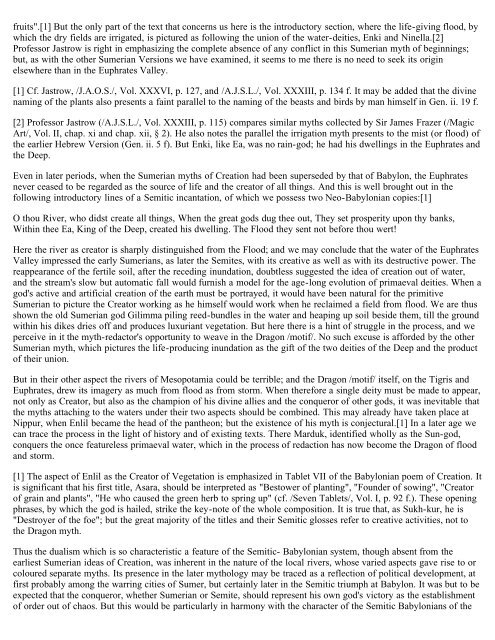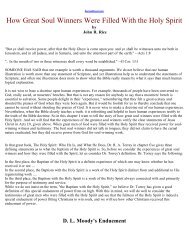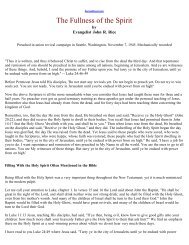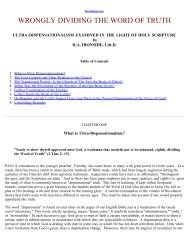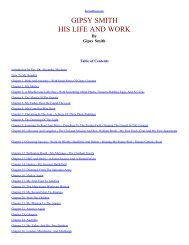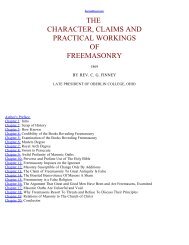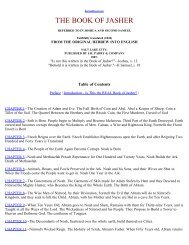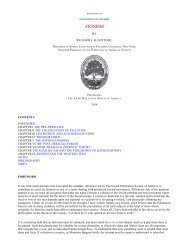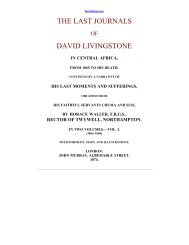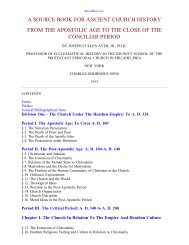Legends of Babylon and Egypt in Relation to Hebrew Tradition.pdf
Legends of Babylon and Egypt in Relation to Hebrew Tradition.pdf
Legends of Babylon and Egypt in Relation to Hebrew Tradition.pdf
Create successful ePaper yourself
Turn your PDF publications into a flip-book with our unique Google optimized e-Paper software.
fruits".[1] But the only part <strong>of</strong> the text that concerns us here is the <strong>in</strong>troduc<strong>to</strong>ry section, where the life-giv<strong>in</strong>g flood, by<br />
which the dry fields are irrigated, is pictured as follow<strong>in</strong>g the union <strong>of</strong> the water-deities, Enki <strong>and</strong> N<strong>in</strong>ella.[2]<br />
Pr<strong>of</strong>essor Jastrow is right <strong>in</strong> emphasiz<strong>in</strong>g the complete absence <strong>of</strong> any conflict <strong>in</strong> this Sumerian myth <strong>of</strong> beg<strong>in</strong>n<strong>in</strong>gs;<br />
but, as with the other Sumerian Versions we have exam<strong>in</strong>ed, it seems <strong>to</strong> me there is no need <strong>to</strong> seek its orig<strong>in</strong><br />
elsewhere than <strong>in</strong> the Euphrates Valley.<br />
[1] Cf. Jastrow, /J.A.O.S./, Vol. XXXVI, p. 127, <strong>and</strong> /A.J.S.L./, Vol. XXXIII, p. 134 f. It may be added that the div<strong>in</strong>e<br />
nam<strong>in</strong>g <strong>of</strong> the plants also presents a fa<strong>in</strong>t parallel <strong>to</strong> the nam<strong>in</strong>g <strong>of</strong> the beasts <strong>and</strong> birds by man himself <strong>in</strong> Gen. ii. 19 f.<br />
[2] Pr<strong>of</strong>essor Jastrow (/A.J.S.L./, Vol. XXXIII, p. 115) compares similar myths collected by Sir James Frazer (/Magic<br />
Art/, Vol. II, chap. xi <strong>and</strong> chap. xii, § 2). He also notes the parallel the irrigation myth presents <strong>to</strong> the mist (or flood) <strong>of</strong><br />
the earlier <strong>Hebrew</strong> Version (Gen. ii. 5 f). But Enki, like Ea, was no ra<strong>in</strong>-god; he had his dwell<strong>in</strong>gs <strong>in</strong> the Euphrates <strong>and</strong><br />
the Deep.<br />
Even <strong>in</strong> later periods, when the Sumerian myths <strong>of</strong> Creation had been superseded by that <strong>of</strong> <strong>Babylon</strong>, the Euphrates<br />
never ceased <strong>to</strong> be regarded as the source <strong>of</strong> life <strong>and</strong> the crea<strong>to</strong>r <strong>of</strong> all th<strong>in</strong>gs. And this is well brought out <strong>in</strong> the<br />
follow<strong>in</strong>g <strong>in</strong>troduc<strong>to</strong>ry l<strong>in</strong>es <strong>of</strong> a Semitic <strong>in</strong>cantation, <strong>of</strong> which we possess two Neo-<strong>Babylon</strong>ian copies:[1]<br />
O thou River, who didst create all th<strong>in</strong>gs, When the great gods dug thee out, They set prosperity upon thy banks,<br />
With<strong>in</strong> thee Ea, K<strong>in</strong>g <strong>of</strong> the Deep, created his dwell<strong>in</strong>g. The Flood they sent not before thou wert!<br />
Here the river as crea<strong>to</strong>r is sharply dist<strong>in</strong>guished from the Flood; <strong>and</strong> we may conclude that the water <strong>of</strong> the Euphrates<br />
Valley impressed the early Sumerians, as later the Semites, with its creative as well as with its destructive power. The<br />
reappearance <strong>of</strong> the fertile soil, after the reced<strong>in</strong>g <strong>in</strong>undation, doubtless suggested the idea <strong>of</strong> creation out <strong>of</strong> water,<br />
<strong>and</strong> the stream's slow but au<strong>to</strong>matic fall would furnish a model for the age-long evolution <strong>of</strong> primaeval deities. When a<br />
god's active <strong>and</strong> artificial creation <strong>of</strong> the earth must be portrayed, it would have been natural for the primitive<br />
Sumerian <strong>to</strong> picture the Crea<strong>to</strong>r work<strong>in</strong>g as he himself would work when he reclaimed a field from flood. We are thus<br />
shown the old Sumerian god Gilimma pil<strong>in</strong>g reed-bundles <strong>in</strong> the water <strong>and</strong> heap<strong>in</strong>g up soil beside them, till the ground<br />
with<strong>in</strong> his dikes dries <strong>of</strong>f <strong>and</strong> produces luxuriant vegetation. But here there is a h<strong>in</strong>t <strong>of</strong> struggle <strong>in</strong> the process, <strong>and</strong> we<br />
perceive <strong>in</strong> it the myth-redac<strong>to</strong>r's opportunity <strong>to</strong> weave <strong>in</strong> the Dragon /motif/. No such excuse is afforded by the other<br />
Sumerian myth, which pictures the life-produc<strong>in</strong>g <strong>in</strong>undation as the gift <strong>of</strong> the two deities <strong>of</strong> the Deep <strong>and</strong> the product<br />
<strong>of</strong> their union.<br />
But <strong>in</strong> their other aspect the rivers <strong>of</strong> Mesopotamia could be terrible; <strong>and</strong> the Dragon /motif/ itself, on the Tigris <strong>and</strong><br />
Euphrates, drew its imagery as much from flood as from s<strong>to</strong>rm. When therefore a s<strong>in</strong>gle deity must be made <strong>to</strong> appear,<br />
not only as Crea<strong>to</strong>r, but also as the champion <strong>of</strong> his div<strong>in</strong>e allies <strong>and</strong> the conqueror <strong>of</strong> other gods, it was <strong>in</strong>evitable that<br />
the myths attach<strong>in</strong>g <strong>to</strong> the waters under their two aspects should be comb<strong>in</strong>ed. This may already have taken place at<br />
Nippur, when Enlil became the head <strong>of</strong> the pantheon; but the existence <strong>of</strong> his myth is conjectural.[1] In a later age we<br />
can trace the process <strong>in</strong> the light <strong>of</strong> his<strong>to</strong>ry <strong>and</strong> <strong>of</strong> exist<strong>in</strong>g texts. There Marduk, identified wholly as the Sun-god,<br />
conquers the once featureless primaeval water, which <strong>in</strong> the process <strong>of</strong> redaction has now become the Dragon <strong>of</strong> flood<br />
<strong>and</strong> s<strong>to</strong>rm.<br />
[1] The aspect <strong>of</strong> Enlil as the Crea<strong>to</strong>r <strong>of</strong> Vegetation is emphasized <strong>in</strong> Tablet VII <strong>of</strong> the <strong>Babylon</strong>ian poem <strong>of</strong> Creation. It<br />
is significant that his first title, Asara, should be <strong>in</strong>terpreted as "Bes<strong>to</strong>wer <strong>of</strong> plant<strong>in</strong>g", "Founder <strong>of</strong> sow<strong>in</strong>g", "Crea<strong>to</strong>r<br />
<strong>of</strong> gra<strong>in</strong> <strong>and</strong> plants", "He who caused the green herb <strong>to</strong> spr<strong>in</strong>g up" (cf. /Seven Tablets/, Vol. I, p. 92 f.). These open<strong>in</strong>g<br />
phrases, by which the god is hailed, strike the key-note <strong>of</strong> the whole composition. It is true that, as Sukh-kur, he is<br />
"Destroyer <strong>of</strong> the foe"; but the great majority <strong>of</strong> the titles <strong>and</strong> their Semitic glosses refer <strong>to</strong> creative activities, not <strong>to</strong><br />
the Dragon myth.<br />
Thus the dualism which is so characteristic a feature <strong>of</strong> the Semitic- <strong>Babylon</strong>ian system, though absent from the<br />
earliest Sumerian ideas <strong>of</strong> Creation, was <strong>in</strong>herent <strong>in</strong> the nature <strong>of</strong> the local rivers, whose varied aspects gave rise <strong>to</strong> or<br />
coloured separate myths. Its presence <strong>in</strong> the later mythology may be traced as a reflection <strong>of</strong> political development, at<br />
first probably among the warr<strong>in</strong>g cities <strong>of</strong> Sumer, but certa<strong>in</strong>ly later <strong>in</strong> the Semitic triumph at <strong>Babylon</strong>. It was but <strong>to</strong> be<br />
expected that the conqueror, whether Sumerian or Semite, should represent his own god's vic<strong>to</strong>ry as the establishment<br />
<strong>of</strong> order out <strong>of</strong> chaos. But this would be particularly <strong>in</strong> harmony with the character <strong>of</strong> the Semitic <strong>Babylon</strong>ians <strong>of</strong> the


